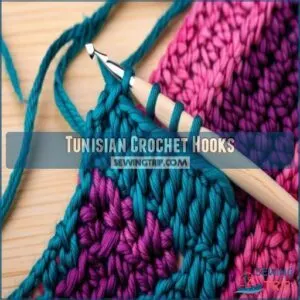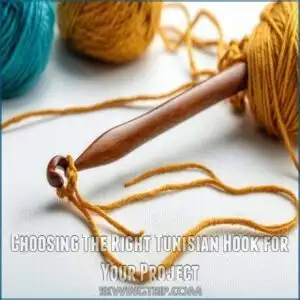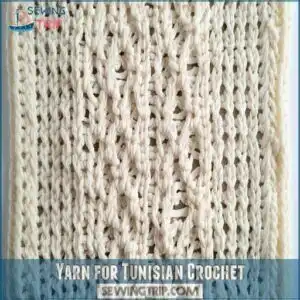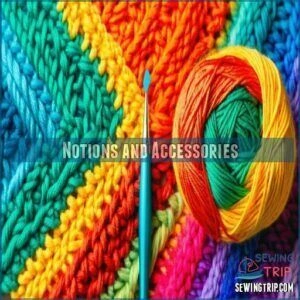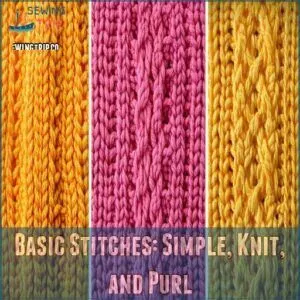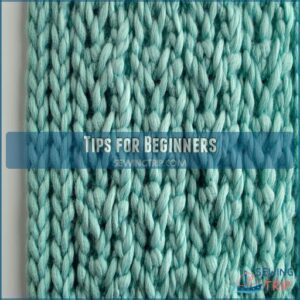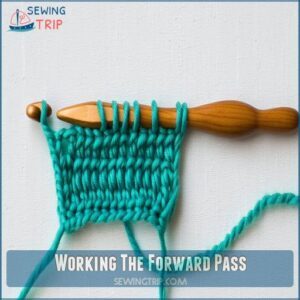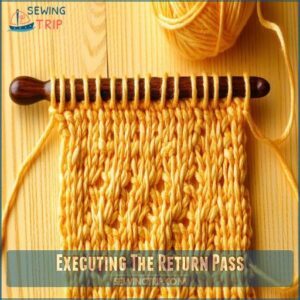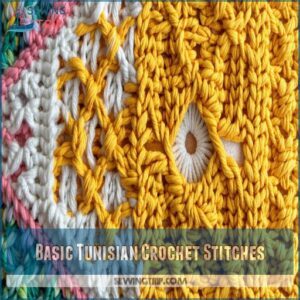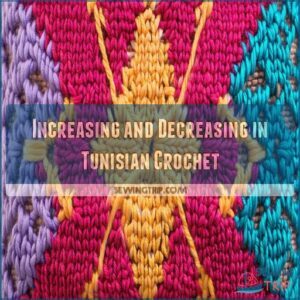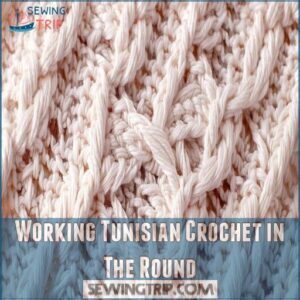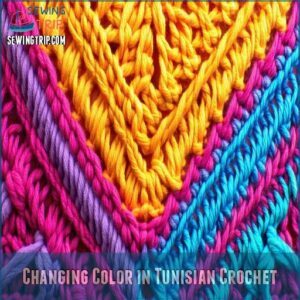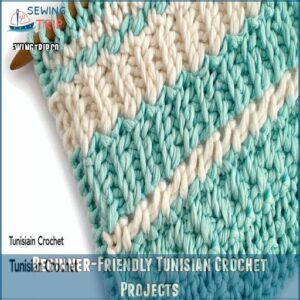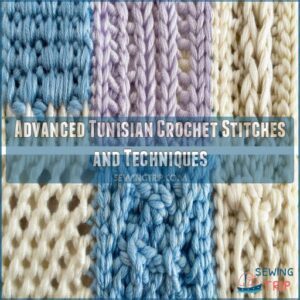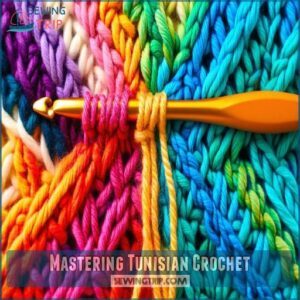This site is supported by our readers. We may earn a commission, at no cost to you, if you purchase through links.
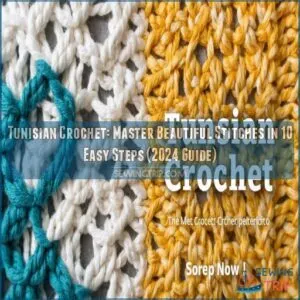 You’ll love Tunisian crochet – it’s like knitting and regular crochet had a crafty baby!
You’ll love Tunisian crochet – it’s like knitting and regular crochet had a crafty baby!
Using a longer hook, you’ll create gorgeous textured fabric by working multiple loops at once through forward and return passes.
While it uses more yarn than standard crochet, you’ll breeze through projects faster than knitting.
Start with basic stitches like the Tunisian simple stitch for a woven look, or try the knit stitch for that classic V-shaped pattern.
From cozy scarves to stunning sweaters, you’ll master beautiful textures that’ll make your projects stand out.
There’s a whole world of unique stitches waiting to transform your crafting game.
Table Of Contents
- Key Takeaways
- What is Tunisian Crochet
- Essential Tools and Materials
- Getting Started With Tunisian Crochet
- Basic Tunisian Crochet Stitches
- Increasing and Decreasing in Tunisian Crochet
- Working Tunisian Crochet in The Round
- Changing Color in Tunisian Crochet
- Beginner-Friendly Tunisian Crochet Projects
- Advanced Tunisian Crochet Stitches and Techniques
- Mastering Tunisian Crochet
- Frequently Asked Questions (FAQs)
- Conclusion
Key Takeaways
- You’ll discover that Tunisian crochet creates unique textured fabrics that combine elements of knitting and crochet, ideal for projects like blankets and garments.
- Master the basics by focusing on the forward and return passes, which help you build a dense fabric faster than regular crochet.
- Starting with beginner-friendly projects like scarves, dishcloths, and small blankets lets you practice essential stitches while creating useful items.
- As you advance, explore taller stitches and techniques like bobbles and puffs to add depth and visual interest to your projects.
What is Tunisian Crochet
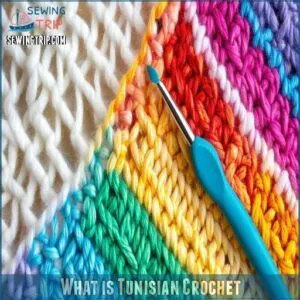
You’ll find that Tunisian crochet combines the best of knitting and regular crochet, using a longer hook to work multiple stitches at once.
With this unique craft, you can create dense, textured fabric that’s perfect for blankets and garments.
Tunisian crochet works faster than traditional knitting while adding your own creative flair.
Defining Tunisian Crochet
Think of Tunisian crochet as the perfect blend of knitting and traditional crochet.
You’ll use a longer hook to create unique textures by working multiple loops at once.
Unlike regular crochet where you complete one stitch at a time, Tunisian crochet involves two passes – forward and return – giving you beautiful, dense fabric with a distinctive look.
It’s faster than knitting but uses more yarn than standard crochet.
What Can You Make With Tunisian Crochet
Tunisian crochet opens up a world of creative possibilities.
You can craft cozy accessories like scarves, hats, and mittens, or tackle larger projects like blankets and shawls.
Looking to spruce up your home? Try making placemats, cushion covers, or wall hangings.
For fashion-forward makers, Tunisian crochet clothing includes cardigans, sweaters, and even dresses.
Plus, you’ll create unique gifts that friends and family will treasure.
What is The Difference Between Crochet and Tunisian Crochet
Crocheting with a traditional hook feels like working on a tightrope, while Tunisian crochet gives you a safety net of multiple active loops.
The main difference lies in how you work the stitches and the tools you use.
While regular crochet works one stitch at a time, Tunisian crochet keeps multiple loops active on a longer hook.
- Creates a denser, warmer fabric perfect for cozy winter wear
- Offers more stability with multiple active stitches
- Uses about 25% more yarn for extra plushness
- Combines the best of knitting and crochet techniques
- Produces uniquely textured fabrics that stand out
Essential Tools and Materials
You’ll need a few basic tools to start your Tunisian crochet journey, including a special long hook that’s different from regular crochet hooks.
Tunisian crochet depends on choosing the right supplies.
Let’s explore what you’ll need to create beautiful projects that’ll make your friends wonder how you did it.
Tunisian Crochet Hooks
Your special tool for this craft is longer than regular crochet hooks – they’re like magic wands that hold multiple loops at once.
They come in sizes from tiny E/4 (3.5mm) to chunky N/15 (10mm).
You’ll find these hooks in aluminum, bamboo, plastic, and even ergonomic styles with cushy grips.
They’re available as straight hooks for narrow projects or with cables for wider pieces.
Choosing The Right Tunisian Hook for Your Project
Picking the perfect hook makes all the difference in your project’s success.
When selecting a Tunisian hook, consider these key factors:
- Project width: Choose straight hooks for scarves and narrow items, or cabled hooks for blankets and wider pieces
- Hook material: Aluminum for speed, bamboo for grip
- Hook length: 10-14 inches for most projects
- Handle comfort: Ergonomic grips prevent hand strain during long sessions
Yarn for Tunisian Crochet
Now that you’ve got your hook ready, let’s talk about yarn selection.
Unlike regular crochet, Tunisian creates a denser fabric, so choose yarn with care.
Here’s what works best:
| Yarn Type | Best For | Not Great For |
|---|---|---|
| Worsted Weight | Most Projects | Delicate Items |
| Cotton Blends | Summer Wear | Winter Warmth |
| Wool Blends | Warm Garments | Beach Items |
Start with light-colored, medium-weight yarns – they’ll help you see your stitches clearly while you’re learning.
Notions and Accessories
Beyond hooks and yarn, you’ll need a few essential tools for Tunisian crochet success.
Stitch markers help track pattern repeats, while a tapestry needle weaves in loose ends.
Keep measuring tape handy to check gauge and project dimensions.
Don’t forget scissors for clean cuts and a project bag to keep everything organized.
These simple accessories make a world of difference in your crafting journey.
Getting Started With Tunisian Crochet
You’ll find that starting Tunisian crochet is easier than you think, as you only need to master two basic movements: the forward pass and return pass.
With your longer hook in hand and yarn ready to go, you can begin creating beautiful fabric by working these simple passes, which will soon become second nature to you.
Basic Stitches: Simple, Knit, and Purl
With your tools ready, let’s explore the building blocks of Tunisian crochet.
The Simple, Knit, and Purl stitches form your foundation for creating beautiful textures. Each stitch has its own personality:
- Simple stitch creates a dense, woven fabric perfect for blankets
- Knit stitch mimics traditional knitting, ideal for sweaters
- Purl stitch adds raised bumps for texture
- Combining these stitches opens endless creative possibilities
You’ll find these stitches flow naturally once you get into a rhythm.
Tips for Beginners
Starting your Tunisian crochet journey doesn’t have to be overwhelming.
Choose a light-colored, medium-weight yarn that won’t split easily – it’ll help you see your stitches clearly.
For a smoother start, you can also check out some beginner-friendly Tunisian crochet products [Tunisian Crochet Beginner](https://zon.everysimply.com/tunisian+crochet+beginner/dp/ to help you get the right tools and materials.
Keep your tension loose and consistent, and don’t worry about perfection right away.
Practice the simple stitch until it feels natural, then gradually explore other basic stitches.
Remember, even experts started exactly where you’re now.
Working The Forward Pass
The forward pass is where your Tunisian crochet journey really begins.
You’ll insert your hook from front to back, picking up loops as you work across the row.
Keep your hook placement consistent and maintain even tension – think of it like collecting pearls on a string.
As you gather each loop, they’ll stay on your hook until you’ve reached the end.
Executing The Return Pass
Return pass mastery marks your journey from beginner to confident crocheter.
You’ll yarn over and pull through two loops at a time, maintaining even tension as you work backward.
Don’t rush – steady movements help prevent loose stitches.
When you reach the last loop, give it a gentle tug to secure your work.
Different stitches may require slight variations in your return pass technique.
Basic Tunisian Crochet Stitches
You’ll find four essential stitches that form the foundation of Tunisian crochet: the simple stitch, knit stitch, purl stitch, and full stitch.
Each stitch creates a unique texture and pattern that you’ll use to make beautiful scarves, blankets, and other cozy items.
Tunisian Simple Stitch
Ready to master your first Tunisian crochet stitch? Here’s the Tunisian simple stitch (Tss) – the foundation of beautiful Tunisian crochet projects. You’ll create a dense, woven-like fabric that’s perfect for beginners.
- Insert your hook under the vertical bar, yarn over, and pull up a loop
- Keep loops on your hook until you reach the end
- Work your return pass by yarning over and pulling through two loops at a time
Tunisian Knit Stitch
Moving up from simple stitches, you’ll love how the Tunisian knit stitch creates a fabric that looks just like knitting.
You can find more resources and products related to the Tunisian Knit Stitch Pattern at Tunisian Knit Stitch.
Insert your hook between the vertical bars of the previous row, yarn over, and pull through – creating that distinctive V-shaped pattern.
Keep your tension loose to prevent curling edges.
This versatile stitch works beautifully for sweaters, scarves, and blankets where you want that classic knitted look.
Tunisian Purl Stitch
The Tunisian Purl Stitch (Tps) adds beautiful texture and dimension to your work.
Unlike the knit stitch, you’ll work this one from the front of your fabric.
Place your hook behind the vertical bar, wrap the yarn from back to front, and pull through to create a bump.
This versatile stitch creates a reversible fabric that’s perfect for scarves, baby blankets, and cozy sweaters.
Tunisian Full Stitch
Looking to create dense, cozy fabric? The Tunisian full stitch adds extra thickness by working into both the vertical bar and horizontal strand.
You’ll insert your hook behind the vertical bar, yarn over, then insert it into the horizontal strand and yarn over again.
This creates a sturdy, textured fabric that’s perfect for blankets, winter scarves, and pot holders.
Increasing and Decreasing in Tunisian Crochet
You’ll find that increasing and decreasing in Tunisian crochet lets you shape your projects into anything from fitted sweaters to unique accessories.
Just like building with blocks, you’ll learn to add stitches where you want fullness and remove them where you need tapering.
How to Increase in Tunisian Crochet
Now that you’ve got the basic stitches down, let’s add some shaping magic to your Tunisian crochet projects.
Increasing is simple: work two stitches into one by inserting your hook under two vertical bars instead of one.
To achieve professional-looking results, mastering the forward and return passes is also essential, as seen in Tunisian crochet techniques.
You can do this at the edges for gradual widening or in the middle for specific shaping.
Just keep your tension even to prevent those pesky holes from forming.
How to Decrease in Tunisian Crochet
Mastering decreases in Tunisian crochet opens up endless possibilities for shaping your projects. Whether you’re crafting a fitted garment or adding subtle curves, you’ll need these essential decrease techniques in your toolkit.
- Work decreases at the beginning of rows by skipping the first stitch
- Combine two stitches together in the middle for centered decreases
- Create slanted edges by working decreases consistently on one side
- Skip the last stitch of a row for edge decreases
- Use stitch markers to track decrease points for complex shaping
Managing Tension in Tunisian Crochet
Many crocheters struggle with tension in Tunisian crochet, but it’s easier than you think.
Start by maintaining consistent hook pressure – not too tight or loose.
Your yarn choice matters too; opt for medium-weight yarns that glide smoothly.
Keep your row gauge steady by using stitch markers every few inches.
If you’re still having trouble, try tension tools like yarn guides or experiment with different hook sizes.
Working Tunisian Crochet in The Round
You’ll find it easier to create seamless tubes and circular projects when you try Tunisian crochet in the round with a double-ended hook.
Working in the round lets you create projects without visible seams, giving your finished pieces a polished look.
Whether you’re making a cozy hat or a stylish cowl, you’ll achieve a seamless, polished look.
Using a Double-Ended Crochet Hook
Double-ended Tunisian crochet hooks open up a whole new dimension of creative possibilities.
These specialized hooks feature points at both ends, letting you work in continuous rounds without turning your work.
You’ll find them in two main types: straight hooks for smaller projects and circular hooks with flexible cables for larger pieces like sweaters and blankets.
Choose a size that matches your yarn weight for best results.
Tips for Working in The Round
Working Tunisian crochet in the round opens up a world of possibilities for creating seamless projects.
Keep your stitch counts consistent by marking your first stitch, and maintain even tension throughout.
When joining rounds, use the crochet slip stitch technique to create an invisible, seamless starting point, then pull the yarn through both loops to create a smooth seam.
For best results, work with a hook size larger than you’d use for flat projects, as rounds tend to pull tighter.
Changing Color in Tunisian Crochet
You’ll find that changing colors in Tunisian crochet is similar to regular crochet, with the new yarn added during the last yarn-over of your stitch.
Striped patterns and colorwork designs that’ll make your projects stand out can be created once you’ve mastered this simple technique.
How to Change Color in Tunisian Crochet
Now that you’ve mastered working in the round, let’s explore adding color to your Tunisian crochet projects.
You’ll change colors during the final yarn over of your last stitch in the return pass.
Simply drop your working yarn, pick up the new color, and complete the yarn over.
Keep your old color loose enough to work with later, but not so loose it creates gaps.
Carrying Yarn Up The Side
Carrying yarn up the side of your Tunisian crochet project keeps your work looking neat while managing multiple colors.
To maintain clean edges and minimize yarn tails, follow these essential steps:
- Leave a long enough tail to weave in later
- Twist the new color around the old one when changing colors
- Keep your yarn tension consistent along the edges
This technique prevents gaps and creates professional-looking colorwork.
Joining New Yarn
The secret to seamless yarn changes in Tunisian crochet lies in the return pass, which is especially important when working with various yarn weights and types, such as wool blends for garments.
You’ll want to join your new yarn during the last yarn over of the stitch, just like in regular crochet.
Once you’ve got both yarn ends hanging, work the next forward pass as usual, making sure to catch and secure those ends as you go.
This technique creates clean color changes without any bulky knots.
Beginner-Friendly Tunisian Crochet Projects
You’ll find that scarves, dishcloths, and small blankets make perfect starter projects for mastering your Tunisian crochet skills.
These simple items let you practice basic stitches while creating something useful.
You won’t feel overwhelmed by complex patterns or large project sizes.
Easy Projects for Beginners
Starting your Tunisian crochet journey is exciting, and you’ll want projects that build confidence while creating something beautiful.
Coasters make perfect first projects – they’re small, quick to complete, and let you practice basic stitches without feeling overwhelmed.
For more cute and fun projects, you can try amigurumi crochet basics, which are great for developing tension and stitch control.
You can also try simple blanket squares or amigurumi animals, which are forgiving and fun to make.
Each project helps you master tension and develop muscle memory.
Scarves and Dishcloths
Scarves and dishcloths naturally become your go-to beginner projects in Tunisian crochet.
You’ll love how quickly these small items work up using the Tunisian Simple Stitch.
For scarves, try working with medium-weight yarn in solid colors before diving into stripes.
Dishcloths are perfect for practicing tension – cotton yarn’s grip helps you master the technique while creating something useful for your kitchen.
Blankets and Home Decor
Once you’ve nailed those basic projects, let’s level up with cozy blankets and eye-catching home decor.
A Tunisian crochet blanket makes an impressive first big project – its unique texture creates stunning patterns that’ll wow your friends.
Try simple throw pillows or placemats to practice different stitch combinations.
The dense, warm fabric of Tunisian crochet works perfectly for these comfort items, and you’ll love seeing them displayed in your home.
Advanced Tunisian Crochet Stitches and Techniques
You’ll open up a whole new world of creative possibilities as you add taller stitches, bobbles, and puffs to your Tunisian crochet projects.
Once you’ve got these advanced moves down, you can mix and match different stitches to create unique textures that’ll make your work stand out.
Taller Stitches
Ready to level up your Tunisian crochet game?
Taller stitches open up a world of exciting texture possibilities.
These variations, like the double and triple Tunisian simple stitch, work just like their regular counterparts but with extra yarn overs.
You’ll wrap the yarn around your hook multiple times during the forward pass, creating beautiful elongated stitches that add dramatic height and visual interest to your projects.
Advanced Stitches: Bobbles and Puffs
Bobbles and puffs transform your Tunisian crochet from flat to fabulous.
You’ll create these eye-catching textures by working multiple loops together in a single stitch.
For bobbles, you’ll complete several stitches partway, then join them at the top.
Puffs are similar but worked more loosely, creating a softer, rounded effect.
To master these techniques, start by understanding the basics of single crochet stitch, then experiment with different yarn weights and hook sizes.
Both techniques add depth and visual interest to your projects.
Combining Stitches for Unique Textures
After mastering those fancy bobbles and puffs, you’ll love mixing different stitches to create eye-catching textures.
Your projects will come alive when you experiment with stitch combinations, and for more inspiration, check out these Tunisian Crochet Texture ideas.
Here are three stunning texture ideas:
- Alternate knit and purl stitches for a cozy ribbed effect
- Mix simple and full stitches for a woven appearance
- Combine honeycomb patterns with basic stitches for dimensional texture
These variations will transform your Tunisian crochet from ordinary to extraordinary.
Mastering Tunisian Crochet
You’ll sharpen your Tunisian crochet skills by learning how to fix common problems and design your own unique patterns.
Once you’ve mastered these advanced techniques, you can create beautiful, professional-looking projects that will last for years.
Troubleshooting Common Issues
Three common headaches in Tunisian crochet can drive you nuts: loose stitches, uneven rows, and dropped stitches.
If you’re seeing loose edges, try tightening your tension on the return pass.
Uneven rows often pop up when you’re inconsistent with your hook placement – keep it steady through the same part of each stitch.
For dropped stitches, double-check your stitch count after each row.
Blocking Tunisian Crochet Projects
Blocking transforms your Tunisian crochet projects from good to great.
Your finished piece might look a bit wonky, but don’t worry!
Here’s what you’ll need to shape and polish your work:
- Steam blocking: Perfect for acrylic yarns – hover your iron about 2 inches above
- Wet blocking: Ideal for natural fibers – soak, squeeze, and pin
- Spray blocking: Quick fix for minor adjustments
- Pin blocking: Essential for lace and detailed patterns
Designing Your Own Tunisian Crochet Patterns
Now that you’ve got the basics down, let’s explore creating your own Tunisian crochet patterns.
Start by sketching your design and planning your colorwork.
Here’s a quick guide to help you bring your ideas to life:
| Design Element | Beginner | Advanced |
|---|---|---|
| Gauge | Simple squares | Multiple swatches |
| Shaping | Basic increases | Complex curves |
| Project Ideas | Scarves, washcloths | Garments, lace |
| Inspiration | Single stitch | Stitch combinations |
Your unique style combined with Tunisian crochet techniques will create something truly special.
Frequently Asked Questions (FAQs)
How to do Tunisian crochet for beginners step by step?
Start Tunisian crochet by choosing a hook two sizes larger than yarn suggests.
Forward and return passes are the foundation of Tunisian crochet. Add loops on the forward pass, remove them on return.
Begin with simple projects like scarves and dishcloths.
Is Tunisian crochet harder than regular crochet?
Tunisian crochet can feel trickier than regular crochet at first.
Its unique tool and technique require some practice,
but once you get the hang of the two-step stitch process, it becomes just as enjoyable.
What is special about Tunisian crochet?
What sets Tunisian crochet apart is its unique blend of knitting and crochet techniques.
It creates a dense, textured fabric that’s perfect for projects like blankets and garments.
All while working faster than traditional crochet.
Is Tunisian crochet a yarn eater?
Imagine the yarn disappearing like magic as you create your masterpiece.
Yes, Tunisian crochet does eat up yarn quicker than traditional methods, but it’s worth it for the rich texture and warmth of your projects.
Are there any free Tunisian crochet patterns?
Loads of websites offer free patterns. Search online for "free Tunisian crochet patterns" – you’ll find tons for scarves, blankets, and more! Happy hooking!
What can you learn in Tunisian crochet?
You can learn to create textured fabrics using unique Tunisian crochet stitches like the Simple, Knit, and Purl stitches.
Master techniques like working with double-ended hooks or changing yarn colors for versatile projects.
What does a Tunisian crochet stitch look like?
Ever wonder if Tunisian crochet looks different from regular crochet?
It does!
The stitches create a distinctive, dense texture resembling a woven pattern, offering a unique look and feel that’s perfect for blankets and cozy garments.
Is Tunisian crochet faster than regular crochet?
Tunisian crochet often speeds up your crafting compared to regular crochet, thanks to its unique technique of holding multiple loops on a hook.
This method makes it quicker for creating larger projects like blankets and garments.
Is Tunisian crochet good for beginners?
Mastering Tunisian crochet is within your reach, even as a beginner.
With the right hook, yarn, and patience, you can create beautiful, textured fabrics and projects.
Tunisian crochet is often faster than traditional crochet.
What is the easiest Tunisian crochet stitch?
You’ll find the Tunisian Simple Stitch, or TSS, the easiest to start with.
It creates a neat, woven look
and is perfect for beginners who want to learn Tunisian crochet without hassle.
Conclusion
Ready to create amazing textures?
You’ve just scratched the surface of Tunisian crochet’s potential.
Remember those gorgeous scarves and sweaters?
Now you can make them!
With practice, you’ll master Tunisian simple stitch, knit stitch, and more.
Explore countless tutorials on Tunisian crochet online for inspiration.
Don’t be afraid to experiment—that’s where the real fun begins.
From simple projects to intricate designs, the possibilities are endless.
So grab your hook and yarn, and let your creativity flow!
Happy crocheting!

